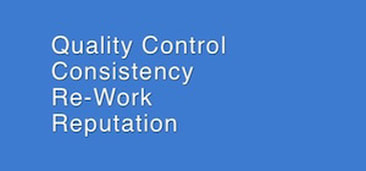|
During my entire career I didn't understand what Project Management should look like. Before I started my own small firm I had only worked in three other small firms - two of them while I was still in school. Project Management was never discussed. The underlying assumption was that once you gathered enough experience, then you knew what to do. Experience was substituted for a process of any sort. I think this is a common problem for architectural firms because 83% of them are small. They have fewer than 10 people. It turns out that my experience in those three small firms fits right into that statistic, all were less than 10 people, including my own firm. Small firms don't know how big firms handle Project Management. Anyway, it is a badge of honor to not be like a big firm. They are so regimented. What small firms never find out is that being regimented helps you to be better - at everything. Yes, there is a small regimentation ‘tax', the cost of setting up and teaching the processes, the regimentation. But unlike most taxes, this one turns out to be an investment that pays dividends. Small firms have to wait for everyone to gain enough experience to know what to do. That will take seven to ten years for each newbie if it ever happens. And when you get that experience, it turns out that each person has their own way of managing projects. The firm as a whole has improved a bit, but they can't improve a lot because they only share a culture, not a process. Once everyone shares a process, the process almost automatically improves. So What's The Problem To recap: Most firms count on experience instead of process. When you are in school the idea that the design of buildings would benefit from a process never comes up. (My experience, anyway.) When you join a firm you learn a lot about how they do things. But it isn't written down anywhere for you to reference it. Small firms don't have the time to document their processes or don't see the need for it. And they don't want big firm regimentation. Big firms have processes or they wouldn't be big. Why is the lack of a handy, documented project management system a problem? Quality Control First there is the problem of quality control. Without a process, quality control is a real issue. Quality control takes a lot of time and it struggles to catch omissions because the person doing the QC review doesn't fully understand the project. So a lot of time is invested in reviewing check-sets because Trust and Money are at stake. Having a process eliminates a lot of this effort. Consistency - Rather, Lack Of
Everybody makes mistakes. The most experienced people make fewer mistakes. The inexperienced make more mistakes. So you assign the experienced people to large jobs where the stakes are higher. These projects are relatively mistake-free. Others, well, those clients aren't as happy. Re-Work Not all your mistakes get built. When you discover a mistake you correct it. Mistakes born of inexperience are usually easier to correct than procedural mistakes. Procedural mistakes can have you redesigning spaces in the working drawing phase. Very time-consuming. Reputation Without a project management process, you surrender your reputation to the lack of consistency. It is hard to be known as first class when the evidence says otherwise. Unprofitable Practice How does a project management process affect profitability? Well, quality control is an expense. Fixing mistakes is an expense. Re-work is an expense. Being passed over for projects because of reputation is like an expense - a lost opportunity. The Problem So the problem with not having a handy, documented project management system is quality control issues, lack of consistency, too much re-work, an unflattering reputation, and difficulty being profitable. What is the solution? Well, building a handy, documented project management system. I know a good way to do that using a no-cost tool called Trello. Stay tuned... Comments are closed.
|
x
Archives
February 2024
Categories
All
|
Architekwiki | Architect's Resource | Greater Cincinnati
© 2012-2022 Architekwiki
© 2012-2022 Architekwiki










